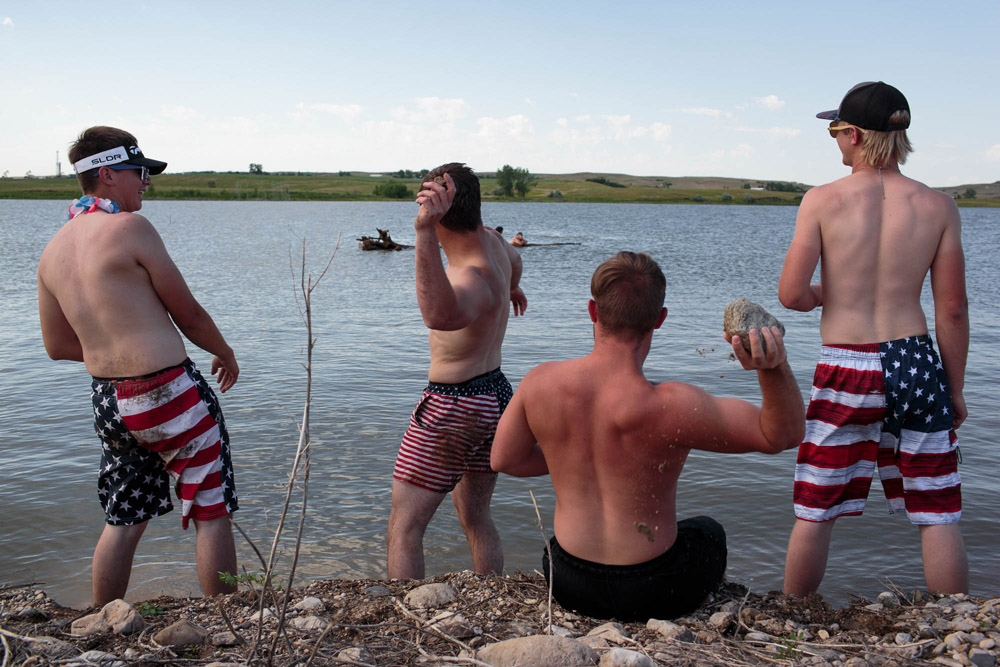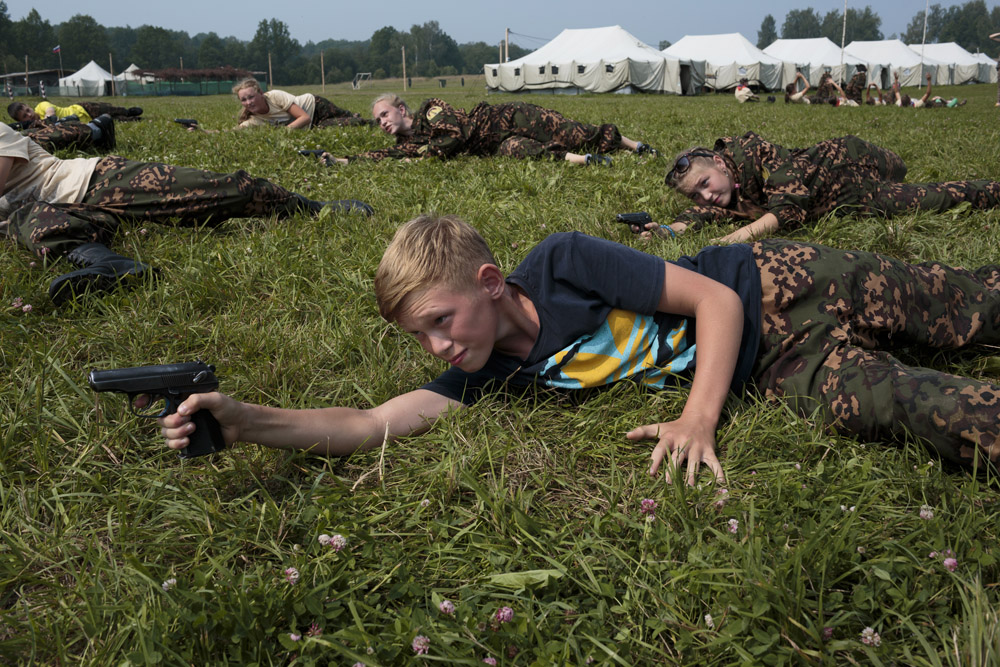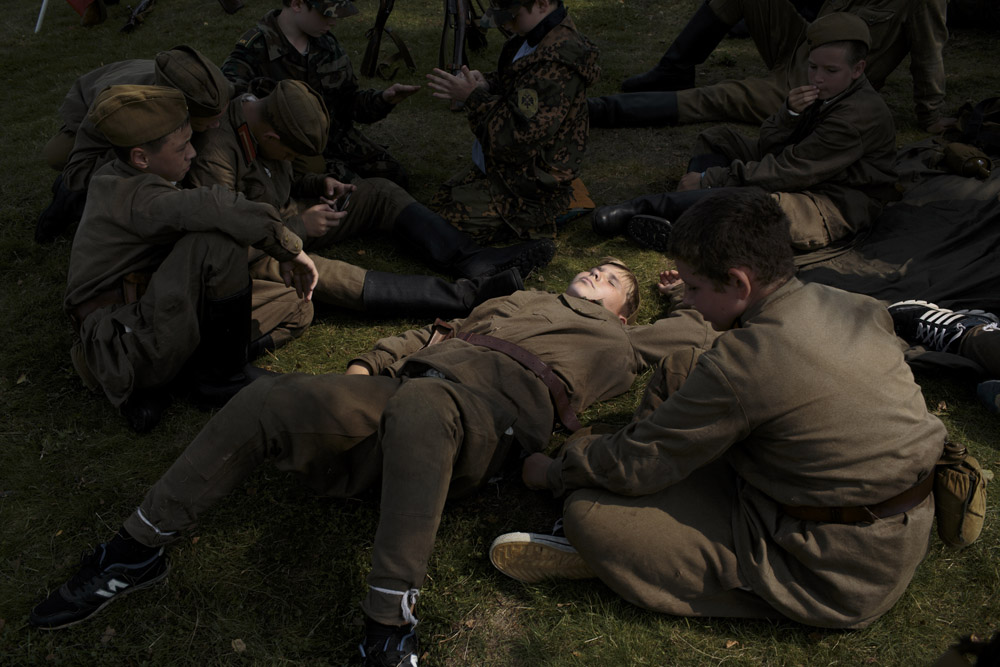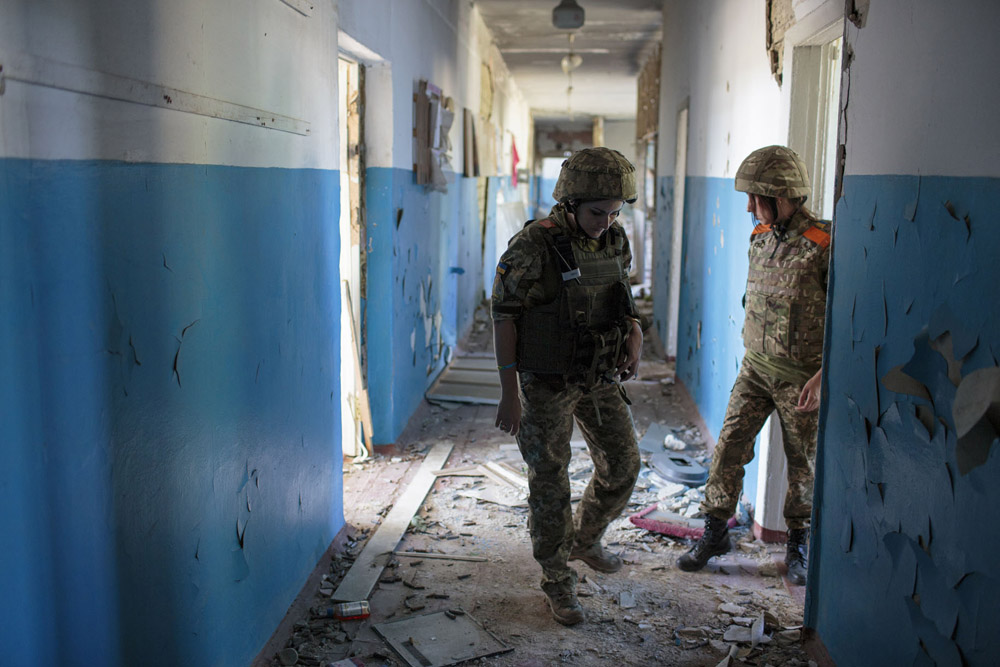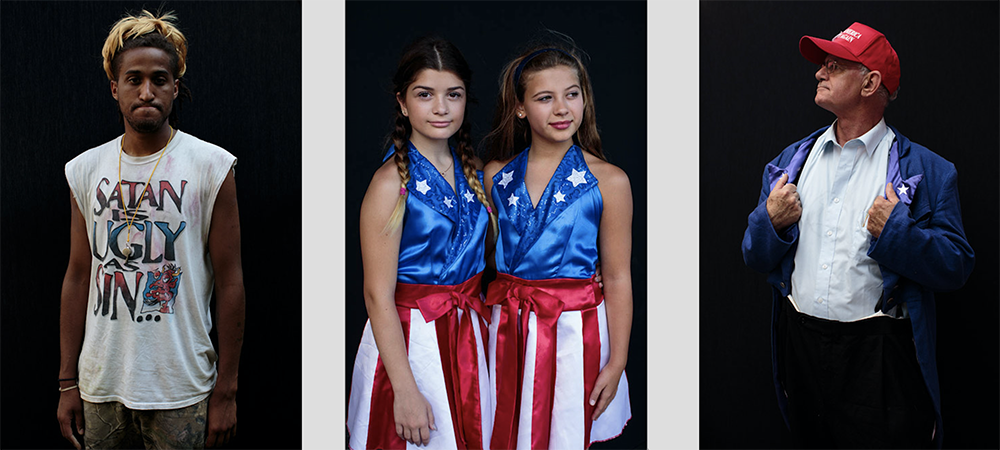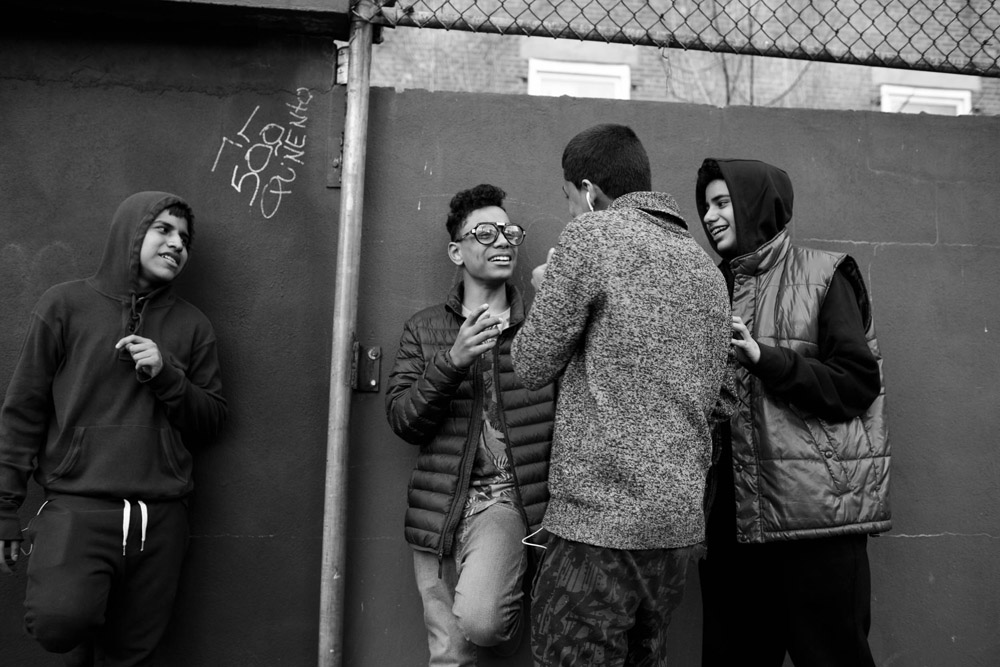Sarah Blesener
Sarah Blesener is a documentary photographer based in New York City. Although her career is just beginning, the ambition, depth, commitment, rigor, and generosity of her projects, vividly demonstrates what documentary can still teach us. Born in Minneapolis, Minnesota, she studied Linguistics and Youth Development at North Central University. While in University, she worked as a photographer for the organization Healing Haiti based in Port au Prince, Haiti, covering events surrounding the 2010 earthquake. Upon graduation in 2012, she studied at Bookvar Russian Academy in Minneapolis, concentrating on the Russian language. She is a recent graduate of the Visual Journalism and Documentary Practice program at the International Center of Photography in New York. Her latest work revolves around youth movements and culture in Russia, Eastern Europe, and the United States. She is a recent recipient of the Alexia Foundation grant for her 2017 work in the United States, and a current fellow with Catchlight, working with Reveal / CIR.
This conversation took place at the School for Visual Arts, New York, August 9, 2017.
MAD: I know you have an interest in language and literature. How did you come to photography?
SB: Yes, my background is in literature and storytelling. Writing is my preference and I have no artists in my family, but my best friend growing up was a photographer gave me a camera to use just for fun. What transitioned me into being a photographer was photographing my brother and sister when I was in High School. They were both going through difficult times. I did a collaborative project with my sister for about a year and it really brought us closer together and I realized that photography could be a way to get to know people better. I hadn’t studied photography, I really had no outside influence, it was just this very personal experience that I had with my sister.
MAD: I read somewhere that some of your earliest photographs were from Haiti.
SB: My mom’s best friend started a non-profit in Haiti and when I was 14 I started to travel there quite a bit and began photographing for the NGO before and after the 2010 earthquake. That was my first documentary work.
MAD: Haiti is a long way from your middle-class Midwest upbringing.
SB: It was shocking at first and photography was a way of processing it for sure. But I was never sheltered as a kid. I had an unconventional youth, I dropped out of school when I was in eighth grade and went to flight school instead. My parents were really hands-off, they told me that as long as I graduate from High School, got a job and didn’t ask for money…..
MAD: (Laughter)
SB: No, it was great advice! I dropped out at 14, finished high school with an online degree, two years early. I was very independent, traveling a lot to visit friends and family in Eastern Europe and Russia. So, although Haiti is unique, it was not the first time I had been in a foreign environment.
MAD: You attended ICP (International Center for Photography) in New York, so you decided to study photography more formally or professionally.
SB: Before ICP I went to undergrad in Minneapolis and studied international studies and youth development, I knew I wanted to work with young people in some capacity. Then I moved to Russia to visit friends and study Russian. My dad’s family is Eastern Europe and I have always been drawn to Russian culture and language. I also worked at an NGO that helps Russian kids after they age-out of the orphanage. I worked there for about six months and at their encouragement tried to document the work being done there but I realized that I had no idea what I was doing, that taking nice photos was not enough. I didn’t have the tools and skills to make a substantial documentary project. A friend of mine recommended ICP, I liked that it was just a one-year commitment.
MAD: What does it take to create a meaningful documentary project?
SB: You need to know what you are saying and why, and you have to believe it. It’s not enough to find an interesting story or an angle, you have to understand what motivates you as a person. I know that sounds very inward, but at ICP it was the only time in my life where I had a year to examine what motivates me, what do I struggle with, what don’t I understand. Those self-searching questions are what can make you a good photographer.
MAD: Clearly you do extensive research for your projects – but how do you not over-prepare? Isn’t discovery also an important part of the process?
SB: That is something I always struggle with. I don’t have a fixed narrative about what I photograph, but I have ideas before I begin. It also depends on the project. Last year I had a very simple idea — I wanted to photograph Russian youth who were involved in politics and patriotic education. I did not have a big agenda, I just wanted to meet some kids and just follow the story. A process unfolded where I would photograph for a couple of months, come back home, review the images, do more research and then return. This year I traveled in the U.S. with the same idea of photographing young people who were involved in politics and patriotic education in some way. But since I applied for grants to help fund the project, I had done a lot of research and writing before I began photographing. But as I started working I realized that in some ways I had done too much research or that my goals were too specific and I had to step back a bit and just visually respond to what was in front of me.
MAD: Can you describe your project Toy Soldiers?
SB: I wanted to look at patriotic education in Russia, particularly summer camps and youth organizations. A Russian friend of mine invited me to photograph at her daughter’s school where she is a cadet. The situation was visually stunning, the colors, the uniforms, what they were doing — for example when I arrived a student greeted me wearing a gas mask.
MAD: How much staging or choreographing do you do while photographing? I ask because some of your images are composed in an almost theatrical way. For example, you have an image of a group of uniformed boys sitting down in the shade, maybe they have been on a hike and are resting. One boy leans back and a single shaft of light illuminates his face — it’s such a dramatic moment.
SB: There is no staging in that kind of situation, my ethics wouldn’t allow me to stage anything, although I am moving around making numerous exposures trying to make the strongest image. You don’t want to overshoot either, I was camping with those kids so I was around them twenty-four hours a day, there is a lot of waiting for the right moment. Although I have not yet written an article to accompany my images, I am writing all the time, from captions to recording things that were said, to keeping track of my own experiences and impressions.
MAD: This is not just a phenomenon in Russia, but are does idea of patriotic education concern you?
SB: I think any kind of militarization of youth is concerning no matter where you are from.
MAD: You don’t express that in the moment when you are observing the kids. I don’t sense a critique guiding your images.
SB: I am talking to the kids all the time. They probably ask me more questions that I ask them. I want to be open to their point of view. I am most struck, in Russia and here in the U.S., by the struggle or tension between the individual and the group, this is especially fraught for adolescents. So, while there is the subject of patriotic education and the enforcement of ideology, it is also about coming of age, about bonding, about the struggle of ‘I’ versus ‘We.’ I want my project to have both threads — the process of indoctrination and the experience of the individual young person. I didn’t grow up this way, and I am critical of the ideas of nationalism and the indoctrination of young people, but I have to balance that with my interest and feeling for the kids themselves. I don’t want to overemphasize the politics.
MAD: I wanted to ask you about another image from Toy Soldiers. It is of a couple dancing on stage, the woman is wearing a gown, the man a uniform. There is a lot going on in that photograph — there are uniformed kids holding images of chess pieces, in the background there is a young person standing between two velvet curtains, he is not wearing a uniform and is compositionally isolated from the rest of what is going on. It’s a complex, multi-faceted narrative that is suggested by that picture.
SB: I was standing back stage during a cadet performance at a local theater right outside of Moscow. The cadet school was performing for the parents. It was an extravagant, four-hour spectacle, there were marches, teachers sang patriotic songs, it was a classic Russian production. I was just about to leave and I saw the couple dancing and the kids marching with the chess pieces. At these cadet schools, they train the girls and boys the same way, there is equality in the rigor of the training. But then you have this counter-narrative happening in which they teach traditional gender roles – which for this performance meant the boys were marching around in their uniforms and their guns, while the girls were decadently dressed in gowns. That morning they were shooting guns with the boys, but in the evening they have to be ladies and display their ballroom dancing skills.
MAD: In another project, The Right to Fight, you document Ukrainian women soldiers who were given the right to serve in battle positions in 2016. There are so many amazing photographs in this series. For example, a young woman in full-camouflage uniform is standing in a trench. She is surrounded, presumably, by male soldiers. She has a very determined look on her face, but she also wears a kind of headdress / scarf and has applied her eyeliner very emphatically.
SB: This young woman was 24 years-old. Her name is Nastya, and she is a sniper for the Ukrainian army. I was drawn to Nastya for two reasons: one, because I was the same age as her when I photographed this series. It was hard for me to wrap my mind around because this was my first time in a war zone, especially being on the front lines. Seeing Nastya, I could see so many parallels to my own life back home. Secondly, because she was almost unapproachable: she was the girlfriend of the commander of the battalion. She was also the top sniper of their unit. In conflict zones, there is so much sitting around just waiting. The positive side of this was spending so much time with these characters, conversation driven instead of photographically driven, unlike some of my other work. It was a lot of gaining trust and waiting for the right moments. Nastya was one of those individuals that you feel is just placed in front of you as a lucky gift. She was incredibly beautiful and kind, and her presence on the army base connected this story for me.
MAD: You are photographing in Russian and Ukraine, who are not officially at war but there is a lot of tension. Where does that place you? Do you try to maintain a professional detachment?
SB: That’s hard, I am not a very detached person in general. If anything, it made me seem untrustworthy to both sides.
MAD: Was that a hindrance?
SB: I am not a conflict or war photographer, so I wasn’t near the Russian encroachment in Ukraine, If I had it would have made things very difficult for me. I tried to explain to the Ukrainians that I had been in Moscow working on a very different project. The kids in Moscow had no idea of the fighting that was going on in the Ukraine, their access to news was much more restricted than mine. The Ukrainians were a bit more used to American or foreign journalists so it wasn’t too much of a problem.
MAD: Speaking of conflict of a different kind, you photographed at last year’s Republican National Convention, mostly portraits. You had just finished ICP right? Can you tell me about that assignment?
SB: I had just graduated from ICP two weeks before. I had never photographed conventions, or protests before, but I had friends going who invited me to join them. I had just taken a portrait class and I decided to try a different approach to photographing the convention. I brought a big piece of cloth that could unfold to be a backdrop. I didn’t have a stand, I just had a friend hold it up for me. We were in the middle of the protest zone and when I chose someone to photograph, my friend would stand behind them and unfold this giant piece of cloth. It was unconventional, to say the least. It was a way to isolate people from the crowd but it also allowed me to have fascinating conversations with my subjects.
MAD: Diane Arbus described the camera as a kind of license, a passport into places and lives one would not normally have access to. When we look at photographs, we often don’t think about the experience the photographer is having, what she did to get the image. Photographers often put themselves in situations so they can learn something, have some sort of exchange that enlarges their experience of life. This leads me to ask you about one of your long-term projects called Haven in which you have been photographing a particular boy and his friends growing up in public housing in New York.
SB: Yes, in the South Bronx. That was my main ICP project which began my journey as a photographer. I want to follow them through High School, from their freshman year through graduation.
MAD: How did you choose that subject?
SB: Out of frustration. ICP was such a challenging experience for me. You have a blank slate, you can photograph anything. That sounds so simple but it raises those questions we were talking about before — what do you really care about? If you cannot defend your choice, should you be even photographing it? All of that was going through my head. I knew I wanted to find a young person to work with — that was all I knew. I met a kid who was taking a photo class at ICP and he invited me to his house to meet his family. I met his cousin Chavi who became the central figure in the project. At the time he was thirteen, and he really stood out, he was interesting, handsome, and polite, so I asked him if I could meet his parents, if I could photograph his daily life. He didn’t understand why I would want to do that, but he agreed if I would give him some photos for Facebook. He introduced me to his friends and again I understood how one’s friends, especially for young people, function as a surrogate family. While I was at ICP I spent at least four days a week with them. These kids live in a rough neighborhood, if you didn’t know them and you saw them walking by you might judge them or write them off. But they are really exceptional human beings, brilliant and funny. I gave them disposable cameras and notebooks, I wanted to see how they would represent their own lives.
MAD: Very recently you have been photographing around the United States in a project that is parallel to what you have been doing in Russia — photographing young people in relation to ideas of patriotism, nationalism, and militarization.
SB: It has only been about five months since I have been working on it, so it’s still in the beginning stages. I researched self-organizing patriotic groups like the Young Marines. Official organizations like the ROTC are interesting but I am more curious about the self-organizing groups like the Young Marines, which is everywhere, it’s a national patriotic youth development organization that has no official ties to the Marine Corps. There a lot of units in Pennsylvania and I went there early on. They do a lot of drills, learning survival skills, they are sponsored by the DEA so they do a lot of drug education. Surprisingly they don’t do any weapons training.
Over the last five months, I have traveled all over the Midwest and the South visiting different camps and programs. One of the issues I have encountered is that everyone is terrified of the media. They are very suspicious and expect that I am going to come in and brand them. In Russia, I did not have to justify or defend myself, my subjects were very open. But here in the U.S., I was seen as part of the mainstream media and not trusted at all. One person asked me if I was going to describe them as the ‘alt –right.’ I assured them that I would not, I am from the Midwest and just truly curious about what is going on.
MAD: Do you think their fear or wariness is justified? That rural or working-class Americans have been represented unfairly in the media in general?
SB: I think we use people all the time to illustrate points or to support editorial agendas. I don’t think it’s solely a liberal or conservative issue. The media might feature a working-class family disillusioned by Trump and it’s a big story but then we leave and forget them. They feel like they were used as pawns and they were. I can understand that frustration. In Russia, I never used Putin’s name. I wanted to understand people’s motivations outside of just one leader. I wanted to understand the larger forces at work. Here I am doing the same thing. It’s not about Trump’s America, I am trying to make it about something beyond the current leaders. I have to really explain that to people.
MAD: Photojournalism is facing a great many challenges because of changing technologies. Newspapers and media outlets are hiring fewer photographers, there are fewer and fewer print publications. Distribution of stories is also a challenge, finding a readership, etc. As someone who is just starting her career, do you find this professionally uncertain time daunting?
SB: I feel somewhat naïve about this since I just entered the profession. I am very new to everything, but I left ICP optimistic and I still feel that way. An overabundance of people with cameras does not relieve the need for qualified photojournalists. People do advise me that I must also do video, to be flexible in which medium I use. But I am not drawn to video. I want to direct all my energies to being a better photographer. I think what is lacking in this environment is long-term investigative documentary work. I might get an assignment to do something in depth with a one-week deadline. How is that possible? It’s not just that the technology is changing is the quick turn-around, the short attention spans, the surface-y approach, that is a concern. I feel fortunate that I have been able to approach my projects with more time and let them take over my life. I cannot really speak to the future of the industry, since I am so new to it, I’m probably the last person to ask….
MAD: Or the best person to ask.
SB: I am moved by what I do and that’s what keeps me going. The death of literature has been predicted on numerous occasions but that hasn’t happened fortunately. If I can make a photo essay that is as strong or as moving as the last book I read, I’ll be happy. I look to older forms of storytelling, books, literature, as my model, my inspiration. There is so much hype around new technologies, virtual reality and the like, but it’s all about the story. In terms of what reaches people, it’s about depth and authenticity.
